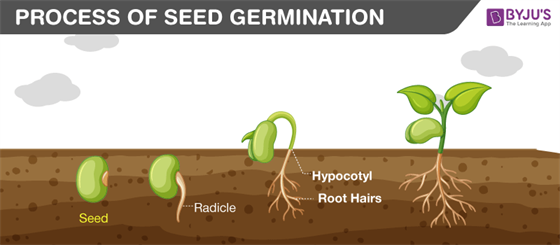Seed Germination
The Process of Seed Germination

In simple words, germination can be defined as the growth of a seed into a young plant or a seedling.
A seed germination is a process by which a different plant species grow from a single seed into a plant. A common example of seed germination is the sprouting of a seedling from a seed of an angiosperm or gymnosperm.
The Process of Seed Germination
The complete process of seed germination is carried out in the following steps:

During the beginning stage of the germination, the seeds take up water rapidly and this results in swelling and softening of the seed coat at an optimum temperature. By rupturing of the seed coats helps to emerge the radicle and the plumule to form a primary root. This stage is referred to as an Imbibition.
After the emerging of the radicle and the plumule, the seed activates its internal physiology and starts to respire and produce proteins and metabolize the stored of food. This is a lag phase of the seed germination.
This is a final stage of seed germination. In this stage, the cell of the seeds are elongated and divides, brings out the root and radicle out of the seed and cotyledons are expanded which are the true leaves of the new plant.
Condition Necessary for Seed Germination
Here are the some of the important requirements which are essential for a seed to germinate into a seedling and to a plant.
Water: it is extremely necessary for the germination of seeds. Some seeds are extremely dry and need to take a considerable amount of water, relative to the dry weight of the seed. But most seeds need enough water to moisten and not soak as it leaks away from a germination inhibitor in the seed. Water plays an important role in seed germination. It helps by providing necessary hydration for the vital activities of protoplasm, provides dissolved oxygen for the growing embryo, softens the seed coats, increases the seed permeability, helps in the rupturing of a seed, and also converts the insoluble food into soluble form for its translocation to the embryo.
Oxygen: It is an important and essential source of energy required for a seed growth. It is required by the germinating seed for the metabolism and is used as a part of aerobic respiration until it manages to grow green leaves of its own. Oxygen can be found in the pores of sand particles, but if the seed is buried too deep it will be deprived of this oxygen.
Temperature: For a seed to germinate, it requires a moderate temperature of around 25-30°C. Quite obviously different seeds require different optimum temperatures. There are some seeds which require special requirements either lower or higher temperature between 5 to 40°C.
Light or darkness: This can act as an environmental trigger. Many seeds refuse to germinate until sunlight falls on them.
The process of seed germination, under the above mentioned favorable conditions, triggers the seed to undergo a rapid expansion growth of the embryo by culminating in rupture of the covering layers and emergence of the radical. This radical emergence is considered the completion of germination.
Factors Affecting Seed Germination
There are some major factors that affect the seed germination. These includes:
External factors
Water: The poor or additional supply of water affects the seed germination.
Oxygen: Germinating seeds respire vigorously and release the energy required for their growth. Therefore deficiency of oxygen affects the seed germination.
Temperature: This affects growth rate as well as metabolism of the seed.
In certain cases, a temperature below the moderate level slows down the seed germination and promotes to the fungal growth. In some cases, the germination stops at the temperature above the moderate level.
Internal factors
Seed dormancy: This is a condition in which the seeds are prevented from germinating even under favorable conditions. During seed dormancy,
The seed coat, which is resistant to water and gases, restrict water uptake and oxygen exchange.
The seeds with undeveloped or immature embryo do not germinate.
Certain seeds contain plant growth regulators which inhibit seed germination.
Some seeds require more time for their germination.
No comments:
Post a Comment